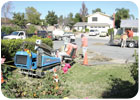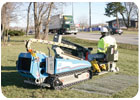
The compact directional drilling market in North America has exploded over the last several years. With the long anticipated bevy of last mile fiber-to-the-home work finally having an impact and glut of gas, water and sewer service and lateral work going around, the compact directional drill has found many stages to demonstrate its capability. Finding work for these drills is one thing, but keeping them in top operational condition is another. With its multitude of considerations, drill maintenance can be extensive, but applying a little common sense will go a long way to keeping your rig up and running.
According to John Olander, directional drilling specialist for trenchless equipment manufacturer TT Technologies, Aurora, Ill, compact drill rig care begins on the job site. He says, “Avoiding accidents and promoting safety are the primary ways crews can help keep their directional drilling equipment performing at its best. It provides the basis for all successful drilling operations. Equipment works better when crews are being safe and following proper drilling procedures. It sounds simple, and it is. But it’s important.”Olander says another key to drill rig maintenance is knowing your rig. He explains, “Drill crews need to know about the equipment they’re using. They need to know what the capabilities are, and make sure they stay within correct and proper usage standards. Most things break when you exceed their tolerance levels. The same is true of drill rigs. And it’s maybe even truer of compact rigs because it seems natural to want to try to push them to their limits or see how much they can do. That can lead to problems and some can be more serious than just equipment failure.”
But beyond working smart and working safe, physical drill rig maintenance is grounded in daily checks and inspections. These checks help alert crews to potential maintenance issues as well as potential safety hazards.
Drill Stem
Proportionately, the drill stem represents the most expensive drill consumable, yet it is easily the most abused, according to Olander. He notes, “In compact drill rigs, the tendency is to exceed the minimum bend radius. This most likely is due to the fact that the drill often is operating in tight working conditions. This puts a tremendous amount of stress on the stems. Inspecting the rods before each use is a must.”Operators should look for several things when inspecting drill stems. First, drill stems should be inspected after each use. The stem threads should be checked to make sure they are clear and adequately lubricated. The threads should not be used dry. Olander says operators should use lubricant specified by the manufacturer – typically a high-pressure copper-carrying lubricant. The threads also should be checked for wear. If the thread profile is becoming significantly worn, the stem should be removed from rotation.
Operators also should look for bent rods. Bent rods transfer additional stress to adjacent rods in the drill string increase the possibility of failures. Bent rods should not be used.
In addition, Olander says changing rod rotation will help extend a rod life, explaining, “Lead rods should be moved to different locations in the drill string from use to use. The lead rods endure the highest amount of stress during drill operations. If left in the lead position, they will tend to fail sooner.”
Finally, Olander suggests checking the drill string drive chuck for wear on a regular basis. He says the condition of the drive chuck can significantly affect the life of the drill-string, and suggests keeping the chuck within 20 percent of new.

Vice
While inspecting the drill stems, giving the vice a quick look also is a must. Inspection items include checking the vice and jaw assembly for wear or chipping. Check to see if pivot points at the wrench and cylinder ends are loose, and replace bushings and pins if needed. Finally, check to make sure that all grease fittings accept grease, and that they are greased as needed.Hydraulics
The importance of keeping a drill rig’s hydraulic system in tip-top shape cannot be overstated. Operators should perform a daily walkaround and check for hydraulic oil leaks. Olander suggests grabbing a flashlight and looking under the machine to check for leaks. He notes, “A small leak will, in time, turn into a larger leak. Look for dampness as well. These small non-dripping leaks usually occur at the hose crimp or at the thread of the fitting. Those are obvious indicators that the hose is going to fail. Replace those hoses a quickly as possible. Of course, make sure to observe all safety precautions when performing checks, especially around live hydraulics.”
Hoses that are susceptible to scuffing, abrasion or other damage because of their location should be regularly checked. Abrasion-resistant material – like spiral wraps or hose sleeves – should be replaced when needed. Olander recommends specifically checking hydraulic hoses that power the tracks for looseness or movement that can cause wear. Hoses with broken wire braids should be replaced immediately.
Hydraulic filters also need attention. Many hydraulic filters today have o-rings as the sealing component. Simply tightening the fitting, as Olander points out, may not fix leak problems. He says, “O-rings need to be replaced as needed. However, the o-rings used in hydraulic fittings are not the o-rings found in many of the ‘off-the-shelf’ assortment kits. They are slightly different in hardness and size. Some manufacturers will specify a specific o-ring grade for high pressure or temperature. It’s always best to contact the manufacturer or follow their recommendations in situations like this.”
Report Abusive Comment